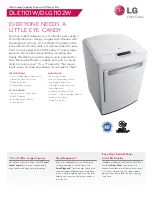
Phillips-head
screwdriver
Duct tape or duct
clamp
Rigid or UL-listed
flexible metal 4”
(10.2 cm) duct
Drill with 1/8” drill bit
(for bottom venting)
Hacksaw
Vent hood
Installation Instructions
EXHAUSTING THE DRYER
- Fire Hazard
WARNING
This dryer MUST be vented to the outdoors.
Use only 4” rigid metal ducting for the home
exhaust duct.
Use only 4” rigid metal or UL-listed dryer transition
duct to connect the dryer to the home exhaust.
DO NOT
use a plastic vent.
DO NOT
exhaust into a chimney, kitchen exhaust,
gas vent, wall, ceiling, attic, crawl space, or
concealed space of a building.
DO NOT
install a screen in or over the exhaust duct.
DO NOT
use duct longer than specified in the
exhaust length table.
Failure to follow these instructions can result in
death or fire.
12
TOOLS AND MATERIALS YOU WILL
NEED TO INSTALL EXHAUST DUCT
CONNECTING THE DRYER TO HOUSE
VENT
RIGID METAL TRANSITION DUCT
•
For best drying performance, a rigid metal transition
duct is recommended.
•
Rigid metal transition ducts reduce the risk of crushing
and kinking.
UL-LISTED FLEXIBLE METAL (SEMI-RIGID) TRANSITION
DUCT
•
If rigid metal duct cannot be used, then UL-listed
flexible metal (semi-rigid) ducting can be used (Kit
WX08X10077).
•
Never install flexible metal duct in walls, ceilings, floors
or other enclosed spaces.
•
Total length of flexible metal duct should not exceed 7’
9” (2.4 m).
•
For many applications, installing elbows at both
the dryer and the wall is highly recommended (see
illustrations at right). Elbows allow the dryer to sit
close to the wall without kinking and/or crushing the
transition duct, maximizing drying performance.
•
Avoid resting the duct on sharp objects.
UL-LISTED FLEXIBLE METAL (FOIL-TYPE) TRANSITION
DUCT
•
In special installations, it may be necessary to connect
the dryer to the house vent using a flexible metal
(foil-type) duct. A UL-listed flexible metal (foil-type) duct
may be used ONLY in installations where rigid metal or
flexible metal (semi-rigid) ducting cannot be used AND
where a 4” diameter can be maintained throughout
the entire length of the transition duct.
•
Only the flexible metal (foil-type) ducts that comply with
the “Outline for Clothes Dryer Transition Duct Subject
2158A” shall be used.
•
Never install flexible metal duct in walls, ceilings, floors
or other enclosed spaces.
•
Total length of flexible metal duct should not exceed 7’
9” (2.4 m).
•
Avoid resting the duct on sharp objects.
•
For best drying performance:
1. Slide one end of the duct over the clothes dryer
outlet pipe.
2. Secure the duct with a clamp.
3. With the dryer in its permanent position, extend
the duct to its full length. Allow 2” of duct to
overlap the exhaust pipe. Cut off and remove
excess duct. Keep the duct as straight as
possible for maximum airflow.
4. Secure the duct to the exhaust pipe with the
other clamp.













































